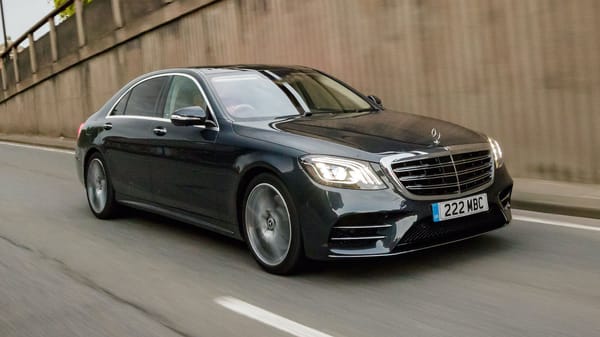A Crucial Element Needed For A Truly Quiet Car: Subframes

Guest post by Doug Tews
Numerous posters on this site have expressed the desire for finding quiet, comfortable cars for driving on European roads. As a US citizen working and living in the UK for over 8 years (and with an engineering background), I might share a few important matters I’ve discovered. I will also share my own personal experience of adding additional sound deadening materials to my UK car; what it accomplished – and what it did not.
Streamlined designs reduced wind noise
Decades ago, wind noise was a significant noise component in road vehicles. In those days, glass was not flush mounted. Items like chrome moldings surrounding the glass created turbulence resulting in wind noise. Turbulence around door mounted mirrors was also a notorious noise maker. However, today’s streamlined designs have significantly reduced such turbulence along with its accompanying noise. The desire for more fuel efficient vehicles lead to these streamlined designs, but with pleasant byproduct of also reducing wind noise. In many of today’s cars, air rushing past the vehicle is still often heard through the doors, but can be quieted by adding sound deadening materials to the door panels.
Acoustic vs. conductive road noise
In today’s cars, road noise is perhaps the single biggest contributor to noisy interiors. Road noise originates from tires running over noisy road surfaces. However, what is not typically recognized, is there are two totally different components to road noise, each requiring a different form of treatment: acoustic noise and conductive noise.
Acoustic noise, as the name implies, is transmitted from the road surface through the air to the car body where it can be heard by occupants inside. This noise is fairly easy to treat by adding sound deadening materials to the floorpan, sheet metal surrounding the cabin and especially the doors.
However conductive road noise is an altogether different problem. This is noise in the form of vibrations conducted from the road surface, through the tires and suspension into the car interior. A great percentage of road noise can enter a car interior via this path. Unfortunately, the only treatment an owner can perform is obtaining quieter tires. A significant issue today is the popularity of low profile tires. The problem: the wheels are very large with very little rubber. Often a significant improvement in noise and ride can be achieved by switching to smaller wheels with higher profile tires. (The outer diameter of the tire is the same. You simply have more rubber on a smaller wheel.) This can make a significant difference, but ultimately the effectiveness is limited by the car’s suspension…and that is the single biggest issue in today’s cars.
Subframes vs. unit-body construction
In the States, most cars made before the mid 1980’s had full-frame suspensions. The tires and suspension components were attached to a steel frame via rubber bushings. The frame in turn was attached through additional rubber bushings to the chassis. In essence, the suspension was “double isolated” from the car chassis. However, nowadays most cars have so-called unit-body construction. In an effort to shave off weight, manufacturers eliminated frames. As a result, the suspension components are now fastened directly to the chassis. Road noise therefore, has a more direct path into the car’s interior.
For luxury cars like Cadillac, this became a big problem. Owners complained bitterly about the increase in noise levels and clunkier ride. The use of larger and better bushings helped, but simply couldn’t match the isolation found in the older cars with frames. Eventually manufacturers responded with the addition of subframes. Unlike the full frames of yesterday, these were smaller and lighter. But like the old frames, they made it possible to much better isolate the suspension components from the chassis and car interior.
I recently had a firsthand experience illustrating the difference subframes can make. In a trip back to the States, I rented a Toyota Corolla. Though bigger than my UK Auris, it is still a smaller vehicle than an Avensis. As soon as I started to drive I was amazed. At speeds up to 20 mph the car was totally, completely silent. There was not a trace of any road noise whatsoever. Nothing. In contrast, as soon as my Auris (and most other small European cars) start to roll, road noise immediately invades the interior. After investigating this, I discovered the US Corolla now has a subframe. The difference was amazing.
Alas, because cars in the UK are far more expensive than in the US, I doubt we’ll see this technology appearing in the smaller cars here. The only exceptions I’m aware of are the Mercedes A & C classes along with the BMW 1 & 3 series vehicles. Of course, these can be pricey. I suspect larger cars like the VW Passat undoubtedly have subframes. But not everybody wants such a relatively big car.
Of course subframes alone don’t guarantee a quiet car. Other appropriate sound deadening measures are required too. However, I wondered, could extensive sound deadening treatment have any effect on conductive road noise? That leads into my own personal experience and what I discovered…
The challenge of silencing conductive road noise
After moving to the UK, I came to the realization that owning a larger comfortable vehicle (even a used, older one) was out of the question due to soaring petrol costs, taxes and insurance. My experience with US Toyotas was so good, I thought the Auris would be appropriate for me. I was able to purchase a 3 year old model with only 15,000 miles on it for a very good price. It was the top trim level loaded with many options. Regrettably, a short test drive on a relatively smooth road was insufficient to reveal the car’s true characteristics. After purchasing the car and gaining experience, it became a significant disappointment. Road noise in particular was horrendous — and the ride was brutally stiff. It didn’t take long for me to start hating the car. However, it was a good buy and Toyotas are dependable, so I decided to see if I could improve things.
First on the agenda was wheels & tires. Although 16 inch tires were standard on the Auris, my top line version came with 17 inch wheels. On eBay I was able to purchase a set of brand new 16 inch wheels for the Auris. I got all four wheels for the price of one. I then had Michelin MXV4 tires put on. My research indicated these were some of the finest tires available for a quiet, smooth ride. After putting the new tires on the new, smaller wheels, the difference was unbelievable. Although nothing can be done about the stiff suspension, the ride was very significantly less harsh and noticeably quieter. The overall improvement in comfort was well worth the expense.
Then came the big project: massive soundproofing. I found a company in the middle of the country that specialized in this sort of work. They put in a double thickness of Dynamat on all metal surfaces, including boot floor, all doors, door panels and roof and bonnet. It was extensive, and expensive.
The results? Unfortunately mixed. First, at motorway speeds the car is noticeably quieter, especially on quiet road surfaces. On a quiet road, one can go from 30 mph up to 50 mph with hardly any discernible increase in noise. Going up to 70 mph does see some increase, but that is primarily just a more distant airflow noise. At about 71-72mph engine hum starts to become the most notable distraction. Before the soundproofing, the car was otherwise so noisy, the engine hum was masked.
However at lower speeds around town (and on noisy highway surfaces which are very common here), the soundproofing was a major disappointment. At speeds below 30-35mph, the improvement was marginal. As soon as the car starts to move, even at 10 mph, road noise intrudes into the cabin. At these lower speeds, virtually 100% of the noise was from conductive road noise.
The importance of suspension design
What was learned? Even massive amounts of sound deadening materials can do little to silence conductive road noise coming through a cheap suspension into a unit-body car. The sound deadening did eliminate all booming from sheet metal that was being excited by the stiff suspension. However, that was a relatively small component of the overall noise.
Having all the sheet metal thoroughly dampened did considerably reduce acoustic noise at higher speeds. On a motorway this can make a very significant difference, but mostly on quieter road surfaces (which are rare here in Britain). Unfortunately on noisy road surfaces, the conductive road noise is so enormous, the greatly reduced acoustic noise was only of very limited benefit.
Between all the the sound deadening, new wheels and tires, I spent over £1500. Was it worth it? I would say yes, but only just. At lower speeds around town, the noise levels are still disappointingly high…and aggravating.
The single biggest improvement (and most cost-effective) was the new wheels and tires. Although sound deadening helps, it’s of limited effectiveness at low speeds. Again, massive soundproofing can do little to stop noise being transmitted into the interior via a cheap, stiff suspension.
The only way we’ll see any significant improvement in this area is for manufacturers to pay more attention to conductive noise in their suspension designs. Although better unit-body suspension designs are possible, manufacturers have discovered there is no better solution than having subframes for really good road isolation.
Therefore, if a person is shopping for a quieter car, finding one that incorporates subframes is extremely important. Earlier I mentioned the wonderful isolation I experienced in that US Toyota Corolla. At highway speeds, most noise I could hear was coming in via the doors – and that is treatable. Therefore, if one took that car and treated it the way I did with my UK Auris, it would probably be as quiet as a luxury vehicle. However, if a lot of noise is coming in via a car’s suspension, there’s little one can do.


